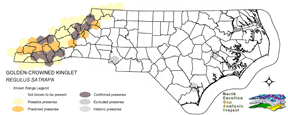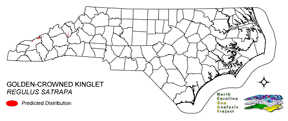
| Taxa: |
| Order: |
| Family: |
| Aves |
| Passeriformes |
| Regulidae |
| NatureServe Global Rank: |
| NatureServe State (NC) Rank: |
| G5 |
| S3B,S5N |
| Federal Status: |
| NC State Status: |
| --- |
| SC |


| Land Unit |
| US Fish & Wildlife Service |
| US Forest Service |
| US National Park Service |
| US Department of Defense |
| NC State Parks |
| NC University System |
| NC Wildlife Res. Com. |
| NC Forest Service |
| NC Div. of Coastal Mgmt. |
| Local Governments |
| Non-Governmental Org. |
| Other Public Lands |
| Private Lands |
| GAP Status 1-2 |
| All Protected Lands |
| Statewide |
| Hectares |
| 0.00 |
| 4,354.20 |
| 0.00 |
| 9,745.29 |
| 441.45 |
| 1.80 |
| 14.85 |
| 0.00 |
| 0.00 |
| 320.04 |
| 748.98 |
| 0.18 |
| 4,808.07 |
| 11,501.28 |
| 15,626.25 |
| 20,434.86 |
| Acres |
| 0.00 |
| 10,759.46 |
| 0.00 |
| 24,081.13 |
| 1,090.85 |
| 4.45 |
| 36.70 |
| 0.00 |
| 0.00 |
| 790.84 |
| 1,850.77 |
| 0.44 |
| 11,881.00 |
| 28,420.28 |
| 38,613.30 |
| 50,495.63 |
| % of Dist. on |
| Prot. Lands |
| 0.0 % |
| 27.9 % |
| 0.0 % |
| 62.4 % |
| 2.8 % |
| < 0.1 % |
| < 0.1 % |
| 0.0 % |
| 0.0 % |
| 4.8 % |
| 4.8 % |
| 0.0 % |
| 0.0 % |
| 73.6 % |
| ----- |
| ----- |
| % of Dist. on |
| All Lands |
| 0.0 % |
| 21.3 % |
| 0.0 % |
| 47.7 % |
| 2.2 % |
| < 0.1 % |
| < 0.1 % |
| 0.0 % |
| 0.0 % |
| 1.6 % |
| 3.7 % |
| < 0.1 % |
| 23.5 % |
| 56.3 % |
| ----- |
| ----- |
|
Found in the mountains, chiefly in the spruce-fir forests, and to a lesser degree in hemlock and white pine forests (Hamel 1992, Simpson 1992). Prefers coniferous forests, usually dense (Kaufman 1996) and mature stands (Hamel 1992). Also inhabits forests of hardwoods mixed with conifers (Hamel 1992). Nests are usually attached to twigs of a horizontal branch of a spruce or other conifer (Ehrlich et al 1988, Harrison 1975, Kaufman 1996, Potter et al 1980). The hanging nest is a mass of moss, lichens, bark strips, spider webs, twigs, and leaves (Ehrlich et al 1988, Kaufman 1996). Golden-crowned kinglets actively hops among branches, twigs, foliage, searching for small insects, larvae, insect eggs, and other small invertebrates (Kaufman 1996). In addition to hopping, they also hover and glean at times (Ehrlich et al 1988). NATURE SERVE GLOBAL HABITAT COMMENTS: Coniferous forest and woodland (especially spruce), in migration and winter also deciduous woodland, scrub and brush (AOU 1983). Nests usually in an evergreen, most often in crown 9-18 m above ground; average about 15 m in northern Minnesota (Terres 1980, Galati 1991). NATURE SERVE STATE HABITAT COMMENTS: Nests in Spruce/fir, and less commonly in white pine and hemlock forests. Primarily above 4500', though nesting pairs are present as low as 3200' in Linville Gorge. |
| Code | Name | Description | NC Natural Heritage Program Equivalent |
| 521 | Spruce/Fir Forest | High Elevation Frazer-Fir - Red Spruce, Red Spruce and Red-Spruce-Yellow Birch Forests. Tree densities included here include both woodland to forest density. Highly intermixed with Northern Hardwoods, Grassy Balds, and Shrub Balds. | Red Spruce--Fraser Fir Forest, Fraser Fir Forest |
| 527 | Appalachian Hemlock | Upland hemlock forests of the moutains region. Vary from side slopes to steep slope positions. | Canada Hemlock Forest |
|
Banks, R. C., and M. R. Browning. 1995. Comments on the status of revived old names for some North American birds. Auk 112:633-648.
American Ornithologists' Union (AOU). 1997. Forty-first supplement to the American Ornithologists' Union Check-list of North American Birds. The Auk 114(3):542-552. Galati, R. 1991. Golden-crowned kinglets:treetop nesters of the north woods. Iowa State Univ. Press. 142 pp. Ehrlich, P.R., D.S. Dobkin, and D. Wheye. 1992. Birds in jeopardy:the imperiled and extinct birds of the United States and Canada, including Hawaii and Puerto Rico. Stanford University Press, Stanford, California. 259 pp. Hamel, P. B. 1992. The land manager's guide to the birds of the south. The Nature Conservancy, Chapel Hill, North Carolina. 367 pp + several appendices. Simpson MB Jr. 1992. Birds of the Blue Ridge Mountains. Chapel Hill and London: University of North Carolina Press. Kaufman K. 1996. Lives of North American Birds. Boston, New York: Houghton Mifflin Company. Harrison, H.H. 1975. A field guide to bird's nests in the U.S. east of the Mississippi River. Houghton Mifflin Company, Boston, Massachusetts. 257 p. Galati, B., and C. B. Galati. 1985. Breeding of the golden-crowned kinglet in northern Minnesota. J. Field Ornithol. 56:28-40. Potter, E. F., J. F. Parnell, and R. P. Teulings. 1980. Birds of the Carolinas. Univ. North Carolina Press, Chapel Hill. 408 pp. Terres, J.K. 1980. The Audubon Society encyclopedia of North American birds. Alfred A. Knopf, New York. American Ornithologists' Union (AOU), Committee on Classification and Nomenclature. 1983. Check-list of North American Birds. Sixth Edition. American Ornithologists' Union, Allen Press, Inc., Lawrence, Kansas. National Geographic Society (NGS). 1983. Field guide to the birds of North America. National Geographic Society, Washington, D.C. Ehrlich, P.R., D.S. Dobkin, and D. Wheye. 1988. The birder's handbook:a field guide to the natural history of North American birds. Simon and Shuster, Inc., New York. xxx + 785 pp. Keast, A., and S. Saunders. 1991. Ecomorphology of the North American ruby-crowned (REGULUS CALENDULA) and golden-crowned (R. SATRAPA) kinglets. Auk 108:880-888. |
For more information please contact them at:
NC-GAP Analysis Project
Dept. of Zoology, NCSU
Campus Box 7617
Raleigh, NC 27695-7617
(919) 513-2853
www.basic.ncsu.edu/ncgap